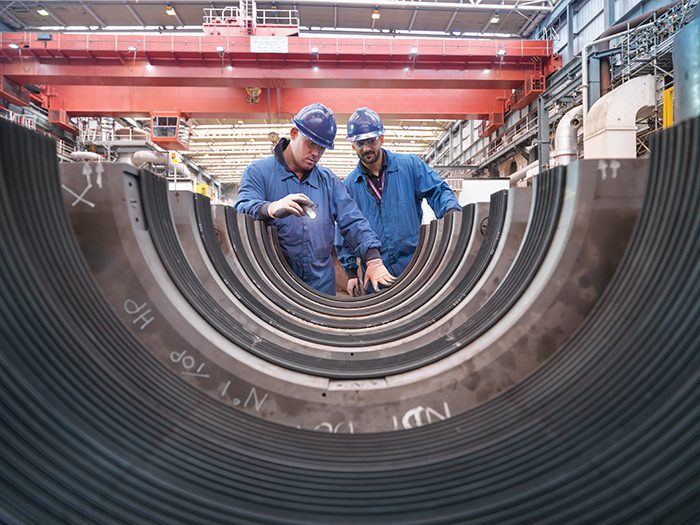Combating Varnish in Turbines: A Two-Step Solution
As operational conditions continue to evolve and change with power generation, so does the degree of complexity within those systems, becoming a common pain point for plant managers that requires rigorous attention to detail. A preventative approach produces drastic savings.
The most critical piece in a power plant? The turbines. A key factor impacting efficient operations? Varnish buildup due to oil degradation, which can reduce operational efficiency or even grind machinery to a halt, often costing operations tens of thousands of dollars at minimum—with some operations facing maintenance, replacement, and downtime costs ranging in the millions. How can plant operators ensure varnish buildup isn’t just something they have to monitor, but a problem that can now be solved completely?
The Problem with Varnish Buildup
Varnish is a term encompassing various types of deposits in oil systems. The range of deposits, which have troubled plant managers for years, run from hard deposits to soft and sticky. To this point, there have been limited solutions.
Typically, varnish forms in stagnant areas and is triggered by thermal events, such as excessive heat, which begins the process of oil degradation leading to the formation of impurities. While impurities within oil are not uncommon, they accumulate, forming suspended submicron particles. Over time, these particles become electrically attracted to metal surfaces, resulting in varnish.
It is important to note varnish does not appear in the oil, but rather on seals and metal surfaces in contact with the oil (Figure 1). In addition to thermal-induced impurities, cross-contamination of oils with incompatible additives is another process resulting in varnish build up. How are plant managers currently trying to solve their varnish buildup issues?
 |
|
1. Steam and gas turbines are among the most critical pieces of equipment at power plants. Reducing varnish building up their oil systems will help them operate more reliably. Courtesy: Chevron |
Past Solutions for Varnish Buildup Not Enough
A common strategy to combat varnish buildup is filtering and high-velocity flushing, which removes weld slag and particulates from the system but typically does not remove deposited varnish. With traditionally available options, filtering and flushing has only been moderately effective, leading to maintenance downtime, increasing costs, lost capacity, and potential penalties from failing to deliver output.
For example, a baseload plant turbine operating at 24 hours a day could see an average of $288,000 in lost sell price to the grid. A merchant plant turbine operating eight hours a day could see upwards of $500,000 in lost sell price to the grid, in addition to an estimated $40,000 cost per turbine per year in varnish-combating maintenance costs. (Results may vary depending on equipment type, operating conditions, and utility costs.) Altogether, varnish build up can amount to hundreds of thousands or even millions of dollars of cost and lost revenue for plants. Some recent solutions have been making headway in solving this ongoing problem.
In discussions with plant managers, we consistently heard several of the same issues arise. In cases where lower lubricant flashpoints were encountered with low volatility components, plant managers had to reduce operating temperatures. Still, there was a higher fire and explosion risk during cleaning or from residual cleaner in the system. Filter plugging was another pain point resulting from the release of a large amount of varnish, potentially exacerbated by incompatibilities with in-service fluids. To mitigate this, costly external filtration and frequent filter changes are necessary, which lead to operational constraints, including unexpected downtime. Even during careful maintenance, residual cleaning chemicals can cause foaming and emulsion issues or may react with oil additives, leading to spillage and air/water being pulled into the system, which can degrade oil quality and performance.
In recent years, the industry has seen an increased adoption of polyalkylene glycol (PAG-based) turbine oils, some claiming to be varnish free. However, a series of 10 industry-standard ASTM tests highlighted some interesting findings.
Conducted by Dr. David Wooton, an independent lubrication and technical consultant, the tests compared a PAG-based formulation and three different mineral oils of both off-the-shelf and in-service samples. Dr. Wooton performed a number of experiments using D2272, the most widely accepted bench test for oxidation, a primary cause of oil degradation and varnish build up.
His results showed similar fail-to-critical varnish levels between PAG-based and mineral oils. Using the ASTM D7843 MPC test, the industry standard for varnish production, results showed a lower propensity to develop varnish than expected, but the buildup was still considered critical. Ultimately, PAG fluid wasn’t “varnish proof,” but instead performed similarly in terms of oxidation and varnish formation. Therefore, a change would be recommended when the fluid reaches 25% of new oil, regardless of base formulation.
As we’ve noted, more permanent varnish buildup solutions are hard to come by, but Chevron recently created an innovative new product for plant managers.
Varnish Buildup No More: Introducing The VARTECH Solution
Chevron’s product development team is constantly focused around “The Chevron Way,” a perspective we uphold by ensuring that the evolving needs of our customers and end-users are central to our business approach. Chevron’s VARTECH Industrial System Cleaner (ISC) and GST Advantage EP and RO is a holistic two-step approach.
The first step is to clean the system. Adding VARTECH ISC near the end of the in-service oil’s life cleans existing varnish while the equipment remains online. It can stay in the system for up to four weeks, providing scheduling flexibility for plant operators to align drain schedules to the most effective times. This cleaning process prepares the system for fresh oil. The second step of the process is to control the development and accumulation of varnish with Chevron GST Advantage EP and RO, which have been formulated to specifically limit the precursors that can precipitate out of the oil and cause varnish. By removing varnish and then inhibiting the precursors of new varnish buildup, a system oil can perform optimally and can therefore support more efficient operations from a cost and output standpoint.
To apply The Chevron Way principles to developing VARTECH ISC, we designed and built a patented varnish test apparatus with the University of California, Merced, to assess cleaner performance in varnish removal. Given there are no universally accepted standards for testing a chemical varnish cleaner’s effectiveness in varnish removal, we validated the performance in numerous lab and field tests in turbine applications.
These tests ranged from offshore platforms to cogeneration power plants. Knowing that fully halting operations to clean can be very costly, we were careful to confirm the compatibility of VARTECH ISC and its effect on oil performance for not only Chevron, but also its competitor lubricants. Now, all plants can benefit from what VARTECH ISC has to offer, even if their standard fills are not Chevron products.
Through rigorous testing Chevron’s VARTECH ISC has been proven to outperform competitors in cutting and capturing varnish, and can reduce the need for flushing during system cleanings. As the latest evolution in Chevron’s well-established line of GST turbine oils, GST Advantage oils are formulated with Chevron’s proprietary VARTECH Technology helping to improve oxidation stability and reduce oil degradation while inhibiting the precursors of varnish formation.
Sycamore and Tahiti Case Studies
For example, the Sycamore cogeneration power plant in Kern County, California, powers thousands of homes and businesses in the southern California desert on multiple Siemens Frame 7 gas turbines, where temperatures can reach 115F. Typically, plants of this type want to run a turbine oil lasting between three to five years before planned maintenance, but Sycamore was not even coming close. The plant used an oil that was breaking down at high operating temperatures. Oil service life was barely 16,000 hours, but after switching to Chevron’s VARTECH solution, service intervals increased to about 48,000 hours (Figure 2).
 |
|
2. Gas and steam turbine unexpected outages are expensive. Investing in a solution with the ability to remove varnish at scheduled outages and provide an oil to inhibit varnish formation during its life can prevent unexpected outages, saving money in the long run. Courtesy: Chevron |
Another example comes from Chevron’s massive spar floating platform in the Tahiti oilfields in the Gulf of Mexico. This single platform operates 24/7, netting daily production averaging 51,000 barrels of crude oil and 22 million cubic feet of natural gas. Running at their constant pace, oil headers in the generator sets were running low and triggering temperature alarms. Maintenance crews tried changing filtration practices and making mechanical modifications to no avail.
The platform contracted a fluid servicing company to add system cleaner to the in-service oil at a cost of $40,000, but problems in the systems persisted. Looking for a different solution, the maintenance crews added VARTECH ISC to the in-service oil. Within 30 minutes, the oil header temperature dropped 8F, and another 7F after 90 minutes, eventually stabilizing the systems and stopping the temperature alarms. Ultimately, this field test saved more than $81,000 in potential maintenance costs, mostly from avoiding oil cooler replacement/refurbishing, which was necessary four times per year at a cost of $20,000 per instance.
Chevron has achieved a breakthrough with its VARTECH solution, but our work and testing continues. Keeping customers and end-users front and center, Chevron is exploring new opportunities with VARTECH ISC. One area of interest? Hydraulic systems in plastic injection molding.
As stated earlier, not all varnish is the same, and this is certainly also true with inorganic anti-wear additive packages in hydraulic fluid, which is why Chevron is looking at further development of new technologies for hydraulic and circulating fluid systems, where varnish continues to be an area of operational challenge. Currently, we endorse the VARTECH ISC as suitable for turbine, and rust and oxidation (R&O) inhibited oils found in turbine and compressor applications, and believe we can provide significant value to an operation dealing with underperforming assets.
Reliable Performance
Turbines are the most critical piece of power plant operations. Without them, everything grinds to a halt. Plant managers need to run their operations as efficiently as possible to maximize operational output. Sacrificing reliable energy production and revenue due to varnish is simply unacceptable.
With new technology and formulations, there is no reason to allow varnish to negatively impact operations to the degree that the industry has historically been accustomed. Using Chevron’s VARTECH ISC, plant managers can clean varnish already present in machinery, and then maintain and control that cleanliness and operational efficiency with GST Advantage formulated oils with VARTECH Technology that are specifically designed to stop varnish buildup before it can start. In doing so, plant managers can empower a more productive and cost-effective operation, saving potentially millions of dollars over the lifespan of machinery.
—Zach Sutton is the Industrial and Services Sector Specialist at Chevron Lubricants.